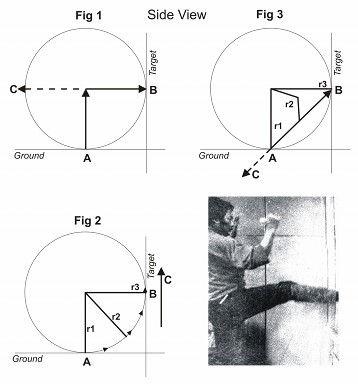
Angle of Attack
In some styles of Ving Tsun, I have seen the kick practised as in Fig. 1. They lift the leg and then kick forward nearly if not parallel to the floor. (“A” to centre and then centre to “B”). This method is not direct as the path of the foot does not go straight to the target, but goes up and then forward. This method also creates another problem in the stability of the kick. According to Newton’s Third Law of Motion, for every force there is an equal and opposite force otherwise known as recoil. When executing any strike, be it with the foot or hand, it is important to understand what direction the equal and opposite force is travelling. Dos it give us more stability or create less stability. With the Ving Tsun punch is rises as it goes forward, creating an equal and opposite force that drives down and roots our stance more into the floor. Quite a few styles of Kung Fu employ this method of structure like Tai Chi, Southern Dragon, Five Animal Style to name a few I have in contact with. Five Animal Style call it the ground force. However, executing the Ving Tsun kick as in the method shown in Fig. 1 created an equal and opposite force that travels backward into the air in the direction of “C” therefore applying a force on the kicker that would make them travel backward from the target. The result of this is the kicker becomes unstable in the stance and some of the force they wish to apply to the power of the kick is absorbed into the recoil as the kicker is pushed away from the target.
In Fig. 2 the kick is executed with the leg kept at the same length (r1, r2, r3 in Fig. 2) – the knee does not bend at all. This method I have also seen in some methods of Ving Tsun. Though this creates a more stable stance as the equal and opposite force travels more into the ground than in the Fig. 1 method, the actual strike does not penetrate the target with the force it could do, as the direction of the kick on impact is more upwards and therefore has the effect of “stroking” the target.
Fig. 3 is the method used in the Wong Shun Leung method of Ving Tsun. The foot travels in a straight line from the floor to the target. This is the most direct, most efficient and therefore fastest method. The path of the foot describes what in trigonomical terms is the “chord” of a circle. Whereas a tangent is a straight line that touches the circumference of a circle just once, a chord of a circle is a line that cuts a circle in two places. The difference therefore between Fig. 2 and Fig. 3 is that the kicking leg, being the radius of the circle, has to bend in Fig. 3 so the radius is shortened and then lengthened again as impact with the target is about to occur (r1, r2, r3 in Fig. 3). This causes the foot to travel in a straight line from where it is on the floor to the target. With this method, physics helps ground the stance as the equal and opposite force is now being directed into the floor in the direction of “C” in Fig. 3. The harder the kicker kicks the target, the more the equal and opposite force drives his stance into the floor creating a stronger and more stable stance on impact.
Wong Shun Leung always demonstrated these various methods of kicking at any of his seminars that involved him explain Ving Tsun kicking methods. He would kick a wall as in the method shown in Fig. 1 which would drive him back from the wall as he kicked. He would then kick using the method shown in Fig. 3 striking the wall very hard, but his stance could be seen to remain stable and strong as impact occurred. The photo shown above of Wong Shun Leung is that of him demonstrating the various kicking methods at his seminar in the UK in St. Albans at my school in 1990.
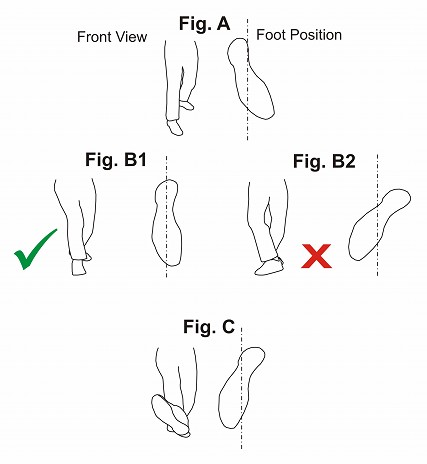
Feet Position
We also need to study the angle of the foot and leg as it moves and
kicks from its position on the floor directly to the target.
Fig. A shows the stance in the position for moving forward and looks at
the kick foot angles from this position. The body is facing forward and
the feet are turned in a little and parallel.
When kicking many people, especially if they feel too close to the
target, they tend to twist the foot much too early to the position it
should be when it is in contact with the target. In fact, they do this
right at the beginning of the kick as in Fig. B2. This immediately opens
up the groin and makes it vulnerable to any incoming force such as an
opponent’s kick.
Fig. B1 shows the correct method. Like in punching where the elbow
covers the centreline, in kicking the foot and knee first cover the
centreline as they travel forward towards the target.
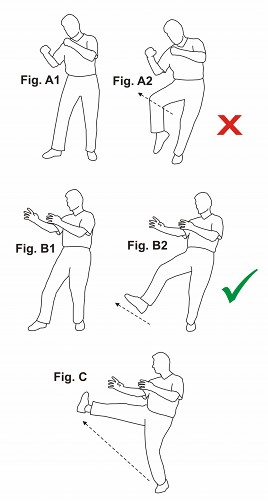
Knee
Position
What is very important as we kick, is the stance. If we kick without our
hips up and forward as in the correct Ving Tsun stance and have the
shoulders leading instead of the hips, we will find we are then leaning
forward slightly as in Fig. A1. In such a stance it is the knee that
rises and leads first, making the shin more venerable for intercepting
any incoming kick as in Fig A2.
With the stance in the correct attitude with the hips up and forward as
in Fig. B2, it is the foot that leads and any incoming kick can be
stopped with the foot as in Fig. B2.
In kick boxing, they block with their shins and to do this, they spend
much time conditioning the shins to be able to withstand blocking kicks.
In the street where people may be wearing boots, the shins would take a
lot of punishment if they blocked a kick with a heavy boot on the foot!
The Ving Tsun method of stopping an incoming kick with the foot leading
is a safer method and circumvents the need for shin conditioning.
Fig. C shows the end position of the kick. When executing the kick it is
like moving forward in the stance but with a kick being added to this
action. The moving forward is driven from the back leg. The hips and
waist are thrown forward adding power to the kick.
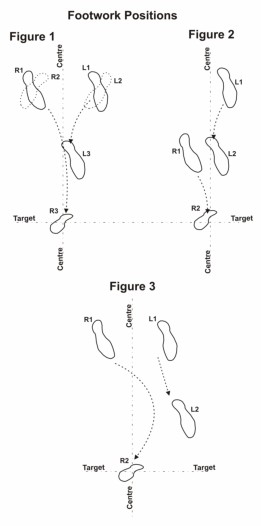
Feet Positions
Figures 1 and 2 show kicking from two
popular positions of stance, the stance when stationary and the stance
when moving. Both Figure 1 and 2 are based on the scenario that the
opponent is in range or is coming forward with a kick so stepping first
to bridge is not necessary. Figure 1 shows two alternatives of standing
stationary with the feet positioned as R1 and L1 where R1 is pointing at
the target and would be the kicking leg or as R2 and L2 where L2 points
at the target and would be the kicking leg. (In all these three
diagrams, R is for the right foot and L is for the left foot.) In Figure
1 R1 is the kicking leg and is driven by L1 pushing forward to generate
the force and therefore negates the need for shifting the body weight to
L1 before kicking as the forward force then compensates for gravity
trying to upset the stance on the side that the foot has left the
ground. This means that if the attacker is initially standing outside
kicking range, he needs to make two actions. (1. to step forward to
bridge the gap and 2. to then kick.) As we drive forward with L1, we
only need one action to kick therefore we are able to stop the
attacker’s step rather than his kick. If we shift our weight before we
kick, then we are also creating two moves and will consequently be
kicking the attackers kick instead of his step. Of course, if the
attacker is within range then driving forward with L1 to kick with R1 is
the quickest way to kick as shifting our weight tells the opponent what
we are going to do before we do it as they are able to see our shoulders
move to the side a little. When the kick is completed and the foot
placed on the floor L1 must move to L3 to re-configure the stance’s
stability.
In Figure 2 the concepts are just the same, but we are already in a
stance moving forward and we kick with R1 by driving forward with L1.
Again, when R1 has reached R2 and is placed on the floor, L1 moves to L2
to re-configure the stance.
In Figure 3 the situation is that of one where we are doing the attacking from a distance more than one step away from the opponent. Of course, if we just step forward in a straight line and kick, we would be clashing with the opponent’s force coming towards us. Thus we have to find a clear line in my creating an angle using dummy footwork. Many years ago I used to try and attack with a kick straight down the centre from a distance of more than one step by reaching a long way with the kick. Of course, this over reaching made my stance very unstable. I remember Wong Shun Leung talking to me and Anthony Kan in Anthony’s back garden explaining to us that we should not kick until we are first in range to kick. He then showed us the footwork as in Figure 3 which creates an angle for entry than does not clash with the centreline. His favourite technique when doing this was to attack with a kick and a man sau all at once. If the opponent tried to block the kick, the man sau would strike. If they tried to block the man sau, then the kick would strike. If the angle of moving from L1 to L2 is as narrow as possible, hopefully it will trick the opponent (especially if they are a karate, Tae Kwon Do or from another style works more in straight lines) into thinking we are moving in, in a straight line. By the time they realise we are not, it is too late for them.
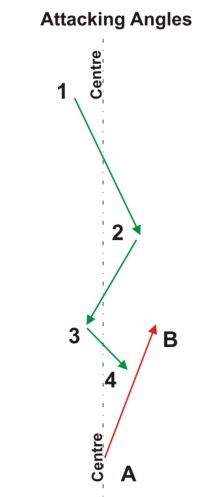
Attack Angles
Of course if we attack as in the last
paragraph, the opponent is not always going to stand there and let us
kick them! Here illustrated is one example of a scenario and how we
might deal with it using Ving Tsun dummy footwork. If we attempt to move
into kicking range via use of an angle as described in the above
paragraph and therefore move from 1 to 2 in the “Attacking Angles”
illustration, the opponent may move or kick from A to B to intercept us.
As he does this we immediately change our direction onto 2 to 3 and move
in again driving off from the back leg in direction of 3 to 4 attacking
perhaps with our hands as we have shut down the kicking distance.
Naturally, there are many, many more scenarios of kicking and kicks from
different angles and positions. Mostly I treat kicks with the same
philosophy and approach as I do the hand actions, for example like
punching, I will kick from wherever my foot is to the target. I have
used the footwork of the “Attacking Angles” illustration to find a clear
way in to attack with the hands. Another way for entry is to attack
directly up the centreline until we obtain contact with the opponent and
to then deal with changing angles to attack depending on the feel of
direction of the opponent’s forces. Like everything in Ving Tsun we must
choose the method that works best for us and develop that for
efficiency.